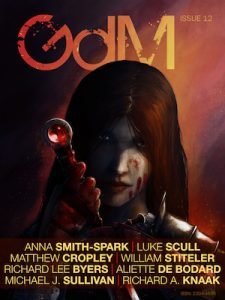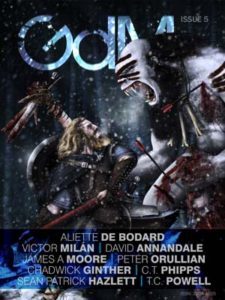Adrian Collins's Blog, page 232
September 4, 2019
4 Grimdark Shows to Watch After Game of Thrones
“The night is dark and full of terrors,” especially now that HBO’s long running show, Game of Thrones, has come to a conclusion. The series finale premiered on May 19th to an audience of 13.6 viewers, capping the show off at a total of 8 seasons, 73 episodes, and 176 on-screen character deaths. The Emmy award winning series first premiered on HBO back in April of 2011. The first five seasons adapt author George R.R. Martin’s books in his A Song of Ice and Fire series, with the last three moving beyond Martin’s published work. Though many characters appear (and die) throughout the show, the main plot centers around three powerful houses in Westeros, the Lannisters, Starks, and the Targarians, in their fight for the Iron Throne and dominion over the Seven Kingdoms.
Both the show and the books are full of all things grimdark, with the many houses declaring war on each other, grey character morality, and satisfying revenge. Now that Game of Thrones’ “watch has ended,” you might be looking for something to fill the void the turbulent series has left behind. While these options are not exclusively considered fantasy, they are most definitely grimdark.
Here is a list of shows filled with dark characters and dark worlds that you might enjoy after watching Game of Thrones.
Death Note
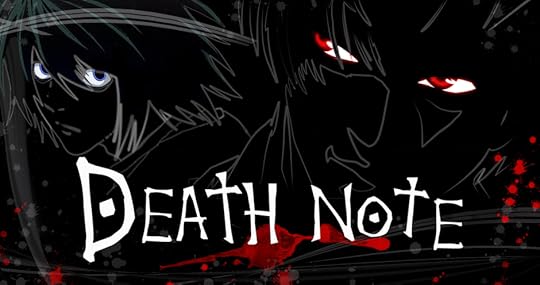
The first entry in this list strays away from the medieval and fantasy style of Game of Thrones in favor of modern Japanese animation. Death Note, based on a manga of the same name, is a popular anime in both Japan and the U.S. The show follows high school student Light Yagami as he finds a powerful supernatural item known as a ‘death note,’ a book that grants him the ability to kill a person by writing their name in its pages. The ‘death note’ belongs to a Shinigami named Ryuk, a death god who has become bored by life in his realm and is looking for a way to be entertained. Light ultimately makes a deal with Ryuk, where he gets to use the death note, thus becoming a form of entertainment for the Shinigami. Taking up the mantle of Kira (Japanes transliteration of ‘killer’) in an effort to cleanse the world of crime by causing mass executions of criminals. His actions soon attract the attention of an elite law task force led by a detective named L, whose goal is to find and put a stop to Kira.
This anime is dark and gritty, combining both thriller and horror aspects to create the world Light and Ryuk inhabit. The colors of the anime, for the most part, are very muted, with whites, greys, blacks, and browns becoming the main palate for the show. Pops of color however are used to emphasise the distinction between “good” and “evil”, with Light often appearing in shades of red, and L appearing in a blue. The character of Light is also an interesting example of grey morality. Light gradually develops a God complex over the course of the anime as the power of the death note goes to his head, his ultimate goal being to create a utopia without violence. Though he believes that his motives are for the good of the world, as crime rates rapidly decline once he beings using the death note, he himself becomes the biggest criminal of them all by using it.
Penny Dreadful
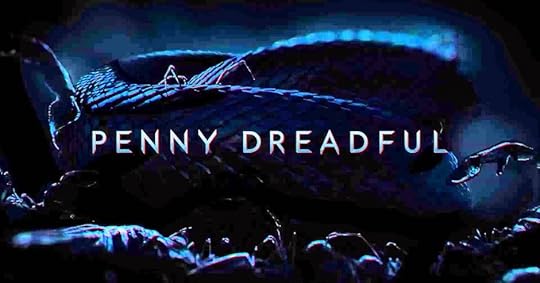
Next on the list is a show that is much more similar to that of Game of Thrones. Penny Dreadful is an American-British series that originally ran on Showtime (it can now be streamed on Netflix). The series consists of three seasons and contains versions of literature’s greatest characters such as Dr. Frankenstein, his Monster, and Dorian Grey, and appearances of famous monsters like vampires, werewolves, and witches. Taking place in 1891 London, the central story revolves around Vanessa Ives, a troubled woman, who struggles with her own, very real demons. A dark force known only as “The Master” is after her in order to complete a prophetic ritual. The title is derived from the 19th century British publications of the same name, that showcased sensational and lurid stories.
As with the Victorian literature that the show draws from, the London that is used as the setting is filled with shadows and death, and you can never be certain what you will find after turning a dark corner. The grim atmosphere is intensified by the show’s characters, as all of them can be viewed as anti heroes in their own right. Ethan, an American cowboy and potential suitor for Vanessa, struggles with his own darkness. A beast lies within him and it is hungry for any blood it can find, and to his credit, Ethan does his best to cage his darkside, though it leads you to wonder if he carries the guilt of his sins with him. Lord Malcolm Murry is another interesting subject. He acts as a father figure towards Vanessa, Ethan, and even Frankenstein, though he is truly concerned with his own hidden motives by assisting Vanessa. The good Dr. Frankenstien is a morally grey character as well, as he previously abandoned his very first creation, the original Monster, and turned to morphine as a way to cope with his sins, as well as committing several other atrocities over the course of the series for the sake of helping another.
The Expanse
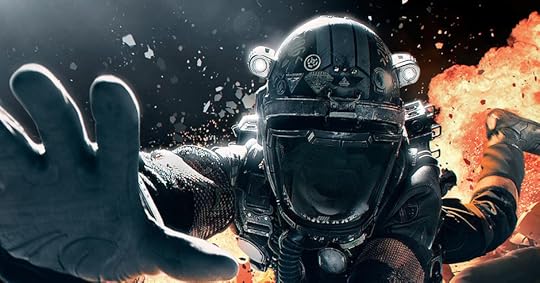
Third up on the list is a show that is out of this world; literally. The Expanse is an American sci-fi series originally distributed by the aptly named SyFy channel. The sci-fi show is based on the novels of the same name by author James S. A. Corey (beginning with Leviathan Wakes). The series takes place in a future where humanity has ventured out into the Solar System, colonizing Mars, the asteroid belt, and several moons, splitting into three factions–Earth, Mars, and the Belt. The central story revolves around a differing cast of characters: UN Security Council member Chrisjen Avasarala, detective Josephus Miller, and Captain James Holden and his crew. Forming an unlikely band of antiheroes, the show follows these characters as they inadvertently find themselves at the center of a conspiracy which threatens the System’s fragile peace, the class balance, and the survival of humanity. The Expanse ran for 3 seasons on SyFy before it was dropped network. All was not lost however, as Amazon Prime Video has picked up the series, renewing it for a fourth season that will be premiering later in 2019.
Since its premiere, The Expanse has been referred to as “Game of Thrones in space.” This observation most likely stems from the overarching similarities between the two shows, such as violence and the ideology that “anyone can die.” Another angle that aligns it with Thrones are the many antiheroic characters. Many of these characters, such as Captain Holden, do not have a clear moral alignment, causing audiences to cheer for them one minute and seriously question their judgement the next. The three factions could double for the various houses within the Thrones universe. Earth, Mars, and the Belt exist in a delicate balance of peace, and it would only take one event to catapult the factions into war. And as with the houses in Game of Thrones, viewers might be more inclined to root for one more than another, while also leave audiences to ponder which of the factions is the true villain. Though The Expanse and GOT share many of the same aspects, the one that shines the brightest is the grey morality. The antiheroes in The Expanse are nothing more than Grimdark space rogues, doing everything they can to survive in the vastness of the galaxy.
Westworld

This list’s fourth and final entry is another cinematic spectacle from HBO. Though it has never become “the next Game of Thrones,” Westworld has left audiences captivated, and completely confused. The two, going on three, season series is a sci-fi western, roughly based on the 1973 film of the same name. The main plot of the show takes place in Westworld, a technologically advanced ‘vacation world’ similar to a theme park. It is here that guests may choose to play on the side of good by donning a white hat, or the side of deviance with a black hat. All of the citizens that reside in Westworld are highly advanced robots called “hosts,” who offer different story lines that guests are able to play while visiting. Though the hosts are meant to be incapable of causing intentional harm, a small group of them begin to retain memories from previous encounters with guests, allowing them to begin learning that the world they live in is a lie.
While you might have to choose between a black or white hat to enter Westworld, grey is the true color of morality when it comes to the various humans and robots in the show. Dr. Robert Ford is an intriguing character to apply this to. Being one of the founders of Westworld he is one of the few people who realize how human the hosts can be to some. However, Ford is often quick to tell his staff not to treat them as humans in anyway, even going on to perform dehumanizing acts on them himself. Similar to Light in Death Note, Ford sees himself as somewhat of a god, as he helped create all of the hosts and he has the power to determine what they say or do by introducing new narratives to the park. The narrative he attempts to introduce however may have ulterior motives behind it.
Go on, get your post-Game of Thrones fix
Whether it’s Japanese death gods or robotic cowboys, these shows are sure to excite and pull you into their turbulent worlds. Grey morality not only adds significant depth to a character, but it also challenges the viewer to decide whether they lean more towards evil or good. Though winter came and went, Game of Thrones will still live on to challenge our own moral decisions, and the shows on this list will do the same. Grimdark can be found in all kinds of places, not exclusively in a world with knights and fire breathing dragons, as more often than not, we can find it in places similar to our own.
The post 4 Grimdark Shows to Watch After Game of Thrones appeared first on Grimdark Magazine.
September 3, 2019
REVIEW: Three Crows Magazine issue 4
This is the third (out of four) issue of Three Crows Magazine that I’ve had the privilege to read to date. And although they have already published some really great short stories in previous issues, so far this one was my favourite. Three Crows Magazine‘s team really outdid themselves with this one.
 This magazine, similar to Grimdark Magazine is published quarterly, featuring short stories, interviews, reviews, and other articles related to all things SFF. As their staff is pretty diverse, they represent this diversity in their content—be it an established author or a debuting one, be it grimdark, sci-fi, magical realism, be it an Asian, Western, Eastern-European setting, everything can find its place within these pages.
This magazine, similar to Grimdark Magazine is published quarterly, featuring short stories, interviews, reviews, and other articles related to all things SFF. As their staff is pretty diverse, they represent this diversity in their content—be it an established author or a debuting one, be it grimdark, sci-fi, magical realism, be it an Asian, Western, Eastern-European setting, everything can find its place within these pages.
In the fourth issue you can find three short stories by Avra Margariti, Stephen Couch and Eliza Chan—find my mini reviews below—an interview with G.V. Anderson and Evan Winter, reviews of: A Collection of Obsessions by Michael R. Fletcher; Children of Ruin by Adrian Tchaikovsky; A Ritual of Bones by Lee C. Conley; Engraved on the Eye by Saladin Ahmed and an essay on the development of desert narratives from the Dune to Empire of Sand.
I highly recommend checking Three Crows Magazine #4 all out, and in case you need further encouragement, here is what I thought of the short stories published in this issue:
Little Bear by Avra Margariti
Little Bear is what I would call atmospherical—if there is a word like that. It gripped me right from the first sentence and never let go. It doesn’t have much of a world building or intricate plot, but its simplicity, and the hinted brutality of the world works pretty well together. I don’t want to reveal anything about the story, because it’s beautiful, heart wrenching and brutal which you have to experience for yourself, without expectations and knowing what hit you. Little Bear reads a bit like a fable of old times, a myth, which doesn’t necessarily have a happy ending, but tells how the world really is, instead of dressing it in pink and sprinkling glitter on it to be more acceptable. There is nothing explicit in the writing, no gruesome scenes, and still, at the core there is something really dark. That kind of darkness that’s part of life, the darkness that dwells within.
I definitely will take a look at Margariti’s other work.
In Cube Eight by Stephen Couch
It’s not much of a secret that me and sci-fi aren’t really on the best of terms. Anything about A.I.s, spaceships, advanced technology just makes my head spin and I just blink like a fish thrown on land suddenly. So, that said, it’s really hard to win me over with anything sci-fi related. Maybe that’s also why I rate harsher works like that. I promise it’s nothing personal, just my own preference, really. I always tried to be as objective as I can be though. And the reason I got into explaining all this is, that I absolutely have no idea where to put In Cube Eight. As short stories go, it’s a good one. A bit mysterious and leaves you wondering which of the three dreams were true—I have a pretty good idea myself.
In Cube Eight is kind of a psychedelic UFO hunting story while not only people but the A.I. gets high too. It’s an interesting idea. I didn’t really understand what was going on until about the halfway mark, and then I got interested. It didn’t blow me away as Little Bear did (which affected me more emotionally), but got me thinking instead. I would have liked to learn more about the characters, to be able to connect them in a way, but other than that, I can see why this one was chosen for the magazine.
Knowing Your Type by Eliza Chan
Whoa. I really dig Knowing Your Type. It’s creepy and has a twist that I’m really not sorry about. Actually, I kind of waited for it to happen and would have been disappointed if it didn’t. There is something satisfying reading about justice served. I’m trying hard not to go into details so I won’t spoil it for you, but let me just say this: Karma is a bitch. And has a sadistic sense of humour. I recently read a novel with a plush toy as the main character, and that story made me all warm and fuzzy, this one made me keep my distance from them… Read it, you’ll understand. I liked that it had an Asian-like setting—I mean, one of the main characters were a Japanese girl, duh—and I’m inclined to find out more about the author’s other works.
Buy Three Crows Magazine #4
The post REVIEW: Three Crows Magazine issue 4 appeared first on Grimdark Magazine.
August 31, 2019
COVER REVEAL: Smoke and Stone by Michael R. Fletcher
Books are weird.
This isn’t my first. It is, in fact, the fifth, and I’ve written two more since this one (you’ll see those next year). And yet every time is a surprise. Every time is like the first. Though perhaps that has something to do with how bad my memory is.
Writers often say that books are never really finished. It’s true. You don’t so much finish a novel as reach a point where you don’t know what else to do with it. That’s the point at which you stand up and say, “I think I just wrote a book.” And every time that, too, is a surprise.
The weird thing is that for something you never really finish, you finish writing a book many times.
That moment when you complete the first draft.
The third draft.
When you get the feedback from your test readers and have cut out two POV characters and rewritten everything in a different tense.
When you’ve finished the ninth draft.
When you’ve gone through all your editor’s comments and changes and fixed everything.
Each of these feels like finishing a novel.
But yesterday the Smoke and Stone author proofs arrived with Felix Ortiz’s art and the final typography. I sat at my kitchen table staring at the book. I picked it up, turned it in my hands, read the back-cover copy, and put it back down. I picked it up again and cracked it open to stare blankly at the words within.
“I wrote a book,” I said to my wife, in wonder.
She stared at me like I was a lunatic. It’s a look I get a lot.
But now it was real. Now it was a book.
Now it was finished!
And I think I came awfully close to not having that experience.
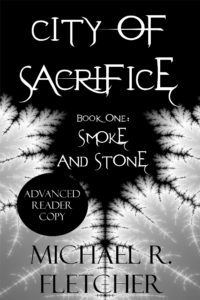 You see, I wasn’t going to hire an artist. I couldn’t afford one. My budget being limited, I’d decided to spend it hiring Sarah Chorn to edit. I made my own cover, a cool looking black and white Mandelbrot fractal. I splashed some typography on it and was pleased with the result. But when the Advanced Reader Copies with my cover arrived, I didn’t have that It’s finished! feeling. I didn’t realize it at the time.
You see, I wasn’t going to hire an artist. I couldn’t afford one. My budget being limited, I’d decided to spend it hiring Sarah Chorn to edit. I made my own cover, a cool looking black and white Mandelbrot fractal. I splashed some typography on it and was pleased with the result. But when the Advanced Reader Copies with my cover arrived, I didn’t have that It’s finished! feeling. I didn’t realize it at the time.
So there I was with my book and a cover I was reasonably happy with that cost me nothing and that evil genius Felix Ortiz posts a link to his Artstation page (https://www.artstation.com/felixortiz).
He’s good.
He’s really good.
So I drop him a message complimenting him on his work and we’re chatting and he innocently says, “I want to try doing a fantasy city sometime.”
Smoke and Stone is the first book in the City of Sacrifice series. The whole story quite literally takes place in a city.
I looked at my Mandelbrot cover.
I knew then my budget was blown to hell.
Now, picking my book up off the kitchen table, I know I made the right choice.
For the first time I really am finished this novel.
August 29, 2019
REVIEW: The Black Hawks by David Wragg
I received an uncorrected proof copy of The Black Hawks in exchange for an honest review. I would like to thank David Wragg and Harper Voyager for the opportunity.
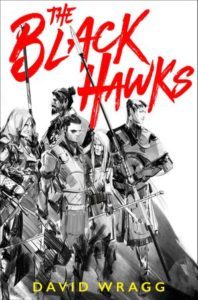 Chel is from a minor noble house and is bored to death working for his step-uncle. He has no real ambitions. He misses his family and cannot wait until he can see them again. The city Chel now resides within is attacked by the Norts with their giant black ships that fling fireballs and huge silk birds who breathe flames on the unfortunate. During the destruction and uncertainty, Chel escapes the city and appropriates an abandoned horse and carriage to direct himself to his freedom. However, as it transpires Tarfal, the prince of Vistirlar is hiding in the carriage and commands Chel to deliver him safely to his brother. This is where The Black Hawks really begins.
Chel is from a minor noble house and is bored to death working for his step-uncle. He has no real ambitions. He misses his family and cannot wait until he can see them again. The city Chel now resides within is attacked by the Norts with their giant black ships that fling fireballs and huge silk birds who breathe flames on the unfortunate. During the destruction and uncertainty, Chel escapes the city and appropriates an abandoned horse and carriage to direct himself to his freedom. However, as it transpires Tarfal, the prince of Vistirlar is hiding in the carriage and commands Chel to deliver him safely to his brother. This is where The Black Hawks really begins.
I’d describe Wragg’s debut outing as being like an accomplished and engaging mixture of Nicholas Eames and Joe Abercrombie. The mercenary crew The Black Hawks were an absolute joy to follow and I haven’t read about as kooky, diverse and humorous a group since Kings of the Wyld. As fate would have it The Black Hawks cross paths with the “wayward prince and reluctant knight” and following the combined ensemble throughout ambushes, skirmishes, betrayals, alliances, etc… make up for the lion’s share of the novel. We don’t meet the titular gang until about seventy pages in.
Wragg has constructed some exceptional characters here. Chel is the only point of view perspective and he is addictively likable. He is not an overpowered, chosen one who will banish evil from the world. He’s presented as quite the opposite. He is lucky and that is his saving grace. He ends up battered and wounded in every confrontation. He is extremely headstrong and resilient though. I couldn’t help smile when I was following some of his martial exchanges. One example is when he is supposed to save the day and skewer an assailant with a javelin, misses completely and the javelin just bounces off the floor. Although obnoxious at first the prince is also highly likable and as the story progresses I just wanted to reach through the pages and give him a hug. The chemistry between these two main players is truly enjoyable to follow.
The Black Hawks themselves shine. The banter, camaraderie and internal politics/ relationships are well created. The standout members for me were Foss – the affable man-mountain, Spider – the extremely talented assassin who seems to despise Chel, and Loveless – the beautiful, graceful, sex-addicted warrior. There is also a member of the crew called Lemon. Boy, does she know how to swear!
As the first entry in the Articles of Faith series, The Black Hawks isn’t going to reinvent the fantasy scene. Wragg utilises quite a few tropes but he does it skilfully so it never feels dull or like a carbon copy of what has come before in the genre. The pacing of the narrative is frequently breathtaking however it unwinds occasionally at quieter times where we get to learn more about the characters.
The world crafted has a pretty deep history with reference to past battles, religions and races but is never overwhelming. My proof version didn’t include a map but I hope the book will when it is released. The build-up to, and the book’s finale are fantastic and include a huge twist. Also, it concludes on a giant cliffhanger. One of the only negatives about getting to read books early is that I have to wait longer for the sequels and I need to know what happens next! The Black Hawks is an extraordinary debut that is as humorous as it is dark. I’d rank this middle of the grimdark scale and believe that Wragg has a winner on his hands here. Highly recommended.
Buy a copy of The Black Hawks by David Wragg
The post REVIEW: The Black Hawks by David Wragg appeared first on Grimdark Magazine.
August 27, 2019
REVIEW: Faithless by Graham Austin-King
Faithless, from Graham Austin-King (The Riven Wyrde Saga), is an intelligent, complex, exciting, dark, and somewhat transgressive story about a young man’s journey from poor son of a farmer to, well, you’ll have to read it to find out. It is an enjoyable, if not perfect, read that is chock full of clever ideas and resonant themes delivered passionately by its author. The e-tome we received at Grimdark Magazine, weighing in at a hefty 136,000+ words, is labeled as a draft, so I will not be directly quoting from the text in this review. It is the hope of this reviewer that the book that Austin-King ultimately publishes will be significantly shorter.
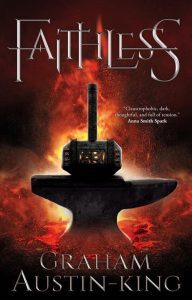 The story follows parallel narratives. First, we are introduced to the boy Wynn via the obligatory scene in which the child of a family too poor to nurture him is sold into a brutal life at a dreadful institution (Blood Song, Red Sister, etc). In this particular case, Wynn is sold into the service of the temple of the Forgefather and relegated to the work in the mines, breaking rocks and mining ore for the temple Forge. Wynn’s narrative takes turns with the narrative of Kharios, a young man, novice of the temple, caught between a rock and a not-so-hard place. (You’ll get the joke when you read it.) These two narratives are both told in very close, limited third-person and converge somewhat late in the novel, but the whole ploy is cleverly planned and deftly handled.
The story follows parallel narratives. First, we are introduced to the boy Wynn via the obligatory scene in which the child of a family too poor to nurture him is sold into a brutal life at a dreadful institution (Blood Song, Red Sister, etc). In this particular case, Wynn is sold into the service of the temple of the Forgefather and relegated to the work in the mines, breaking rocks and mining ore for the temple Forge. Wynn’s narrative takes turns with the narrative of Kharios, a young man, novice of the temple, caught between a rock and a not-so-hard place. (You’ll get the joke when you read it.) These two narratives are both told in very close, limited third-person and converge somewhat late in the novel, but the whole ploy is cleverly planned and deftly handled.
Neither Wynn nor Kharios is an exceptional character and both seem a bit like milquetoasts for most of the story until the final climactic challenge. Similarly both characters are do-gooders, for the most part, though they occasionally regret having to leave friends behind on their way up the temple’s political/religious ladder. Near the end Kharios develops a relationship with Leesha, a girl his own age, and some YA romance is implied (though this is, thankfully, not a YA story. Sorry, kids.) Wynn also has a few friends in the mines and eventually the temple, but no one of special interest to this reviewer, other than Brial, his partner at the forge, who is of limited interest in and of himself but is essential to the plot and the characterizations of the other characters. As such, the characters in Faithless would have been somewhat ho-hum were it not for the Priest, Ossan, who pretty much steals the show.
Austin-King keeps his cards close with Ossan, revealing him at times to be a kindly old Priest, supportive of the boys’ efforts to master the various chants and strokes required to earn their rings of mastery for forging special metalworks inscribed with questionably magical glyphs. At other times, Ossan is a brutal taskmaster, a mean and nasty paternal figure, and much, much worse. Austin-King must have loved creating this character, and it shows. Ossan is deep and dark, yet fatherly and wise, and he speaks beautifully and ponderously, reminding me of old Ultan, the librarian in Gene Wolfe’s Book of the New Sun. It is a beautiful job of characterization, and almost had me rooting for the old Priest despite his numerous egregious faults.
The plot of Faithless takes a while to unfold, perhaps slightly too long. It revolves around Wynn’s episodes experiencing the extremely harsh life of the mines and his wondering what the hell he is doing there when he is supposed to be serving the temple. This is interwoven with Kharios’s search for artifacts related the Fall of the Forgefather and his religion from great mythical power to sniveling servants and peddlers of material goods, metalworks, etc. There has been a physical Fall as well, as we find out that the temple itself was a massive structure before the religion and the building imploded. It’s a clever backstory, and well developed, with a beautifully realized setting, but at times I felt I was reading a Scooby Doo novel in which Shaggy and Scooby are trapped in the mines with scary creatures while Fred and Velma search the library for clues to the mystery. Fortunately, Austin-King turns the action up to eleven as the story rolls toward its frantic, harrowing climax, and ferocious ending.
Adding depth to this overall intelligently constructed story is its main theme, which can be described in a nutshell as Do We Serve God or Does God Serve Us. The question is adeptly presented albeit conclusively answered without much room for speculation, but it does form a solid, thought-provoking glue that holds together the action, suspense, and delightful mayhem in the second half of the story.
The other main element that holds this story together is the very creative and vivid setting Austin-King has created, where most of the action takes place. It’s an underground dystopian city, Aspiration, built in a huge cavern with only a small crack at the top to let smoke out and occasionally a few drops of rain in. The characters must access the cavern through a series of ladders or a makeshift elevator, and from there they can access the mines below, and below that… who knows what lurks? It’s at times claustrophobic, but also gritty, dark, and exceedingly grim. Not only does it serve to set an appropriately hopeless, moody background setting, but it also serves to contain what is often a meandering story. If the old cliché is true that the setting should be a character in the story, then that job is done well here.
While there are many good (and some really good) things going on in Faithless, there are still some things that give me reservations about giving it an unqualified recommendation. I hope some of these things will be addressed before it is released. First of all, it’s way too long for what it is. There are elements that probably could be cut, perhaps even one whole narrative strain could have been folded into the other. It is also riddled with bloated narration in which the author reveals the characters thoughts excessively about things we already know from the action and dialogue. At times, lots of times, I found myself skimming the text in between patches of dialogue since much of it seemed excessive and self-indulgent. The dialogue, other than the speeches made by Ossan, is dull and lifeless and seems to exist only to dump information and plot clues. Some matters of craft also twisted my nipple, such as forced simultaneity, pronoun-antecedent ambiguity, and lack of sentence structure variation, among others—stuff you don’t see as much in fiction published by the big houses, I’m sorry to say. Hopefully, these few little things will be ironed out in the final edit, and even if they are not, only the most knit-picking of dickheads will probably notice them. Hey… wait… a… minute.
Anyhow, for those of us who press on to the end of Faithless, the payoff is big, and overall, it is an intelligently conceived, exciting, and passionately told story.
But is it grimdark? There is certainly no moral ambiguity in the main characters, with the possible exception of Ossan, but despite his split personality, I think it’s a stretch to say that even he is a morally grey character. Yep, there are good guys and bad guys here—and more morally right and wrong situations than you can even guess. So, despite its violence and its persistent and overwhelming grimness, I’m not sure it doesn’t fall more toward heroic fantasy than grimdark. Not that there’s anything wrong with that. Nevertheless, I guess readers should decide for themselves whether this fits into their category of grimdark. For me, it doesn’t really matter. It’s a delightfully grim and dark story that, despite a few minor hiccups, should be a crowd pleaser. Check it out.
•
Originally published in Grimdark Magazine #12.
Grimdark Magazine #12 is available for purchase from our catalogue.
The post REVIEW: Faithless by Graham Austin-King appeared first on Grimdark Magazine.
Review: Faithless by Graham Austin-King
Faithless, from Graham Austin-King (The Riven Wyrde Saga), is an intelligent, complex, exciting, dark, and somewhat transgressive story about a young man’s journey from poor son of a farmer to, well, you’ll have to read it to find out. It is an enjoyable, if not perfect, read that is chock full of clever ideas and resonant themes delivered passionately by its author. The e-tome we received at Grimdark Magazine, weighing in at a hefty 136,000+ words, is labeled as a draft, so I will not be directly quoting from the text in this review. It is the hope of this reviewer that the book that Austin-King ultimately publishes will be significantly shorter.
 The story follows parallel narratives. First, we are introduced to the boy Wynn via the obligatory scene in which the child of a family too poor to nurture him is sold into a brutal life at a dreadful institution (Blood Song, Red Sister, etc). In this particular case, Wynn is sold into the service of the temple of the Forgefather and relegated to the work in the mines, breaking rocks and mining ore for the temple Forge. Wynn’s narrative takes turns with the narrative of Kharios, a young man, novice of the temple, caught between a rock and a not-so-hard place. (You’ll get the joke when you read it.) These two narratives are both told in very close, limited third-person and converge somewhat late in the novel, but the whole ploy is cleverly planned and deftly handled.
The story follows parallel narratives. First, we are introduced to the boy Wynn via the obligatory scene in which the child of a family too poor to nurture him is sold into a brutal life at a dreadful institution (Blood Song, Red Sister, etc). In this particular case, Wynn is sold into the service of the temple of the Forgefather and relegated to the work in the mines, breaking rocks and mining ore for the temple Forge. Wynn’s narrative takes turns with the narrative of Kharios, a young man, novice of the temple, caught between a rock and a not-so-hard place. (You’ll get the joke when you read it.) These two narratives are both told in very close, limited third-person and converge somewhat late in the novel, but the whole ploy is cleverly planned and deftly handled.
Neither Wynn nor Kharios is an exceptional character and both seem a bit like milquetoasts for most of the story until the final climactic challenge. Similarly both characters are do-gooders, for the most part, though they occasionally regret having to leave friends behind on their way up the temple’s political/religious ladder. Near the end Kharios develops a relationship with Leesha, a girl his own age, and some YA romance is implied (though this is, thankfully, not a YA story. Sorry, kids.) Wynn also has a few friends in the mines and eventually the temple, but no one of special interest to this reviewer, other than Brial, his partner at the forge, who is of limited interest in and of himself but is essential to the plot and the characterizations of the other characters. As such, the characters in Faithless would have been somewhat ho-hum were it not for the Priest, Ossan, who pretty much steals the show.
Austin-King keeps his cards close with Ossan, revealing him at times to be a kindly old Priest, supportive of the boys’ efforts to master the various chants and strokes required to earn their rings of mastery for forging special metalworks inscribed with questionably magical glyphs. At other times, Ossan is a brutal taskmaster, a mean and nasty paternal figure, and much, much worse. Austin-King must have loved creating this character, and it shows. Ossan is deep and dark, yet fatherly and wise, and he speaks beautifully and ponderously, reminding me of old Ultan, the librarian in Gene Wolfe’s Book of the New Sun. It is a beautiful job of characterization, and almost had me rooting for the old Priest despite his numerous egregious faults.
The plot of Faithless takes a while to unfold, perhaps slightly too long. It revolves around Wynn’s episodes experiencing the extremely harsh life of the mines and his wondering what the hell he is doing there when he is supposed to be serving the temple. This is interwoven with Kharios’s search for artifacts related the Fall of the Forgefather and his religion from great mythical power to sniveling servants and peddlers of material goods, metalworks, etc. There has been a physical Fall as well, as we find out that the temple itself was a massive structure before the religion and the building imploded. It’s a clever backstory, and well developed, with a beautifully realized setting, but at times I felt I was reading a Scooby Doo novel in which Shaggy and Scooby are trapped in the mines with scary creatures while Fred and Velma search the library for clues to the mystery. Fortunately, Austin-King turns the action up to eleven as the story rolls toward its frantic, harrowing climax, and ferocious ending.
Adding depth to this overall intelligently constructed story is its main theme, which can be described in a nutshell as Do We Serve God or Does God Serve Us. The question is adeptly presented albeit conclusively answered without much room for speculation, but it does form a solid, thought-provoking glue that holds together the action, suspense, and delightful mayhem in the second half of the story.
The other main element that holds this story together is the very creative and vivid setting Austin-King has created, where most of the action takes place. It’s an underground dystopian city, Aspiration, built in a huge cavern with only a small crack at the top to let smoke out and occasionally a few drops of rain in. The characters must access the cavern through a series of ladders or a makeshift elevator, and from there they can access the mines below, and below that… who knows what lurks? It’s at times claustrophobic, but also gritty, dark, and exceedingly grim. Not only does it serve to set an appropriately hopeless, moody background setting, but it also serves to contain what is often a meandering story. If the old cliché is true that the setting should be a character in the story, then that job is done well here.
While there are many good (and some really good) things going on in Faithless, there are still some things that give me reservations about giving it an unqualified recommendation. I hope some of these things will be addressed before it is released. First of all, it’s way too long for what it is. There are elements that probably could be cut, perhaps even one whole narrative strain could have been folded into the other. It is also riddled with bloated narration in which the author reveals the characters thoughts excessively about things we already know from the action and dialogue. At times, lots of times, I found myself skimming the text in between patches of dialogue since much of it seemed excessive and self-indulgent. The dialogue, other than the speeches made by Ossan, is dull and lifeless and seems to exist only to dump information and plot clues. Some matters of craft also twisted my nipple, such as forced simultaneity, pronoun-antecedent ambiguity, and lack of sentence structure variation, among others—stuff you don’t see as much in fiction published by the big houses, I’m sorry to say. Hopefully, these few little things will be ironed out in the final edit, and even if they are not, only the most knit-picking of dickheads will probably notice them. Hey… wait… a… minute.
Anyhow, for those of us who press on to the end of Faithless, the payoff is big, and overall, it is an intelligently conceived, exciting, and passionately told story.
But is it grimdark? There is certainly no moral ambiguity in the main characters, with the possible exception of Ossan, but despite his split personality, I think it’s a stretch to say that even he is a morally grey character. Yep, there are good guys and bad guys here—and more morally right and wrong situations than you can even guess. So, despite its violence and its persistent and overwhelming grimness, I’m not sure it doesn’t fall more toward heroic fantasy than grimdark. Not that there’s anything wrong with that. Nevertheless, I guess readers should decide for themselves whether this fits into their category of grimdark. For me, it doesn’t really matter. It’s a delightfully grim and dark story that, despite a few minor hiccups, should be a crowd pleaser. Check it out.
•
Originally published in Grimdark Magazine #12.
Grimdark Magazine #12 is available for purchase from our catalogue.
The post Review: Faithless by Graham Austin-King appeared first on Grimdark Magazine.
August 25, 2019
REVIEW: Bright Steel by Miles Cameron
Bright Steel. Wow. Masters and Mages is now a finished trilogy, and Bright Steel ramps up every aspect that made Cold Iron and Dark Forge utterly brilliant. Fearsome battles with swords and sorcery, emotional punches, back-alley dealings and one of the best coming-of-age heroes I have read, Bright Steel is a wonderful conclusion to Miles Cameron’s spy-thriller-fantasy Masters and Mages.
“Selfishness and tyranny do not make for stable allies.”
“Can I quote you on that?”
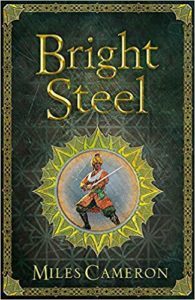 To begin with, I am a massive fan of Miles Cameron. His easy going writing style, authentic detail and memorable characters really create fantastic books. And each one is so different. Each book I read of Cameron highlights how he is changing as an author, writing new and unique material that is unexpected and totally welcome, as well as including all of his trademark elements. Bright Steel is the finale to the trilogy that Cold Iron and Dark Forge deserved. These books are so readable because of the incredible variety of scenes, set-pieces, politics and characters that are within them.
To begin with, I am a massive fan of Miles Cameron. His easy going writing style, authentic detail and memorable characters really create fantastic books. And each one is so different. Each book I read of Cameron highlights how he is changing as an author, writing new and unique material that is unexpected and totally welcome, as well as including all of his trademark elements. Bright Steel is the finale to the trilogy that Cold Iron and Dark Forge deserved. These books are so readable because of the incredible variety of scenes, set-pieces, politics and characters that are within them.
‘When trouble didn’t stay away, it was routinely punched in the head and thrown in the Great Canal.’
Cold Iron introduced us to Aranthur as he unwittingly began a journey as an Academy student who is on the path to greatness. Dark Forge followed Aranthur and the friends he made as he became someone important. Bright Steel continues with Aranthur, exploring the strange and brilliant arc that he has been through. He is a young man who wants to be the best he can be, for himself and those he loves. And he is painfully aware of how the path he leads can easily turn him into an ill-hearted man. He wants to be loyal and generous, kind, to not kill, but he finds himself in scenarios that push his morality. I loved the scenes that explored his awareness of his actions, and the conversations he had with characters about these situations.
The cast behind Aranthur also make this one of my favourite fantasy books to date. Those who readers have grown to love since Book 1, such as Dahlia, Kallatronis and Drako, each have their individual impacts upon this book. As they assist Aranthur and work through betrayals, dire scenarios and joyful occasions as friends, they only added to the story. Cameron’s knack for dialogue in this book in particular was immensely strong, with witty conversations that had me laughing out loud, and serious moments, adding to the realism of their friendships.
‘What is life but the lust for power?’
The story was engaging, fun and intense, with such a diversity of scenes, action pieces and city-politics that meant I was always on my toes. I have found myself each day longing to get back to reading this story. It captivated me so much that I actually missed my bus stop on TWO occasions. It was worth the extra walking (which I also did whilst reading). I believe I would have enjoyed a refreshment in the specific technical terminology. Maybe my brain had accidentally forgot some obvious terms but there are a lot of unique terms to these stories, all of which add to the detail of Cameron’s world-building! One thing that I am usually not a fan of is magic and magical lore. However, this story portrayed the magic in such a way that it felt authentic and real, and I loved the scenes where magic was explored.
Thank you so much to Gollancz for the opportunity to read this amazing story early, and be involved in the blog tour! If you’ve been waiting for a fantasy tale that is unique and fun, tense and bloody, with the famous Cameron battles and urgent stories, please read these books. You won’t regret it.
‘When you two are struggling to set the measure between you, you can step back all you want – back out of the window if you will. But once your blades touch, you must go forward until you conquer or die.’
5/5 – The cover quote (by my dad!) says that the Masters and Mages trilogy is a masterclass in modern fantasy, and I could not agree more. Bright Steel is a story of friendship, the complications of how simple choices affect your life in ways you could not imagine, and how swords in books will never ever get old or boring. Fantastic storytelling.
Buy a copy of Bright Steel by Miles Cameron
The post REVIEW: Bright Steel by Miles Cameron appeared first on Grimdark Magazine.
August 19, 2019
Excerpt: Eye of the Beholder by Trudi Canavan
Trudi Canavan is an Aussie legend, and I’m very proud to be able to publish Eye of the Beholder in Grimdark Magazine Issue #19. Trudi is such a big name in the fantasy genre, especially here in Australia, so go on, get stuck in and have a taste of her gripping short story.
Eye of the Beholder
Trudi Canavan
“You say you want my life story, young man. I know what you really want, and I’m not going to give it to you. We’re going to start at the second chapter. It’s a far more interesting chapter, in my opinion, to the one before.
All you need to know is I’d lost a great deal. Reputation. Station. Trust. My family had disowned me, as had most of my friends. But not all of my friends. Not the knowledge and skill I’d gained, either. What I lost led to an unexpected gain: I was free to turn what had been an interest and pastime into a source of income, with a little help from the friends I had kept.
No, not magic. Not yet.
For a time, I was the most popular miniature portraitist at court. Yes. Me. A woman artist, in those times. It was the size I worked at that made it possible. I made miniatures: small, insignificant portraits that could not compete with all those proud figures standing amid the splendour of their possessions, natural or otherwise, from the walls of the rich and important. My miniatures had more in common with the tiny pictures painted upon porcelain, more delicate and sentimental than grand and imposing. They were seen as decorations rather than art, therefore acceptable work for a woman—though I’d wager none of the portraitists could have done what I did, if they ever deigned to try.
If you needed a likeness to present when arranging a marriage, you came to me. If you wanted a keepsake to remind you of a loved one, or remind a loved one of you, you came to me. If you desired a portable image, not too expensive, to keep by your side, you came to me.
Of course, none of the people I had wronged in the past came to me. Some who knew of my reputation visited to gloat at my reduced circumstances. Some were drawn out of curiosity. Some expressed their support for my role in… that other business. Strange how the latter made me feel most like a failure.
I wasn’t the only one producing miniatures—or the first to do so—but I was the best. I had practiced the art for a long time before needing to make an income from it. I’d had good teachers, too. Women hired to encourage the improvement of young ladies with suitable leisure activities, who could be surprisingly exacting in their lessons for occupations that weren’t supposed to matter that much.
Miniatures had always fascinated me. I’d searched books and interrogated my teachers for information about them. They have a long history, filled with superstition and unlikely stories. Sorting the truth from the myth was an endlessly attractive puzzle for my young mind.
I did not attempt anything illegal, of course. Not before I was ordered to. I want to be perfectly clear about that. Write it down. Good.
Check out the rest of Eye of the Beholder
Read the rest of Eye of the Beholder by Trudi Canavan and much, much more in Grimdark Magazine Issue #19.
The post Excerpt: Eye of the Beholder by Trudi Canavan appeared first on Grimdark Magazine.
August 17, 2019
VG Review: The Witcher 3: Wild Hunt
The Witcher series by Andrjez Sapkowski is one of the seminal works of grimdark literature in Europe. The video game adaptations of the series have since gone on to popularize the series globally. The premise of both the books and the games is a mutated monster-hunter named Geralt of Rivia exists in a low fantasy world of extra-dimensional creatures menacing an un-idealized medieval world. The monarchs are cruel and selfish, the peasantry superstitious and racist; nonhumans are brutally discriminated against but respond with terrorism against civilians; and our hero is never more than a few coins ahead of bankruptcy.
The Witcher 3: Wild Hunt is a direct sequel to The Witcher 2: Assassin of Kings, and culminates a trilogy which purports to wrap up not only Geralt’s story from the video games but his lingering threads from the novel series. Although not all of Sapkowski’s works have been translated into English at the time of this article’s writing, I strongly recommend readers check out the ones that have. Not only are they excellent grimdark fiction but they also serve as a good introduction to the nuanced relationships in the game. Newcomers to the game series won’t be completely lost, however, as the game generally gives you a decent enough introduction to all of the characters.
The gameplay starts as Geralt of Rivia has received a mysterious letter from his former lover, Yennefer of Vengerburg, a sorceress who has been missing for years. Geralt, travelling with his old friend Vesemir, sets out to reunite with her. Their journey is complicated by the brutal and authoritarian Nilfgaard Empire, who have invaded the kingdoms of the North.
Geralt, unlike virtually every other vanilla fantasy hero in fiction, knows the “Empire” isn’t necessarily worse than the local tyrants, and the majority of people who will suffer during the war are those caught between the two sides. The issue of Yennefer is resolved fairly early but only leads to a wider adventure with the discovery that Geralt’s long-lost adopted daughter, Ciri of Cintra, is still alive and in danger of being killed by the terrifying otherworldly Wild Hunt.
If this sounds complex, well, it is.
The developers at CD Projekt Red have done a magnificent job at realizing the world from Sapkowski’s novels and adding their own spin to things. This is quite possibly the most vividly realized fantasy world in gaming history, rivalled only by Dragon Age’s Thedas and the Elder Scrolls universe.
The world is also a great deal more “realistic” than any of these others: full of sex, lies, human weakness, betrayal, and sadness. It is an RPG, so the player can select Geralt’s reactions to almost every situation, but the game frames it so anything is potentially “in-character” for Geralt. There’s no “Good”, “Evil”, or “Indifferent” choices. Instead, they’re more like “Lesser Evil”, “Self-Interested”, and “Not my problem.”
One of the early side-quests in the game illustrates the kind of grey morality that pervades The Witcher. When a local blacksmith asks Geralt to investigate who burned down his forge. Geralt swiftly finds out that it was a nearby teenager who, while drunk, did so because the blacksmith is being forced to shoe horses for the invading Nilfgaard. The penalty for the young man’s “resistance” would be hanging, but he also thinks the largely-innocent blacksmith should die for his “collaboration.” There’s no magical third option that leaves everyone happy and alive.
My favorite plotline in the game is an extended storyline in the Second Act that deals with a local nobleman who has chosen to fully collaborate with the Nilfgaardian invasion and whose men are, by and large, complete scum. The nobleman, obviously inspired by Mark Addy’s portrayal of Robert Baratheon in the Game of Thrones TV series, is an alcoholic spouse-abuser, who also suffers severe mental scars from the horrors he witnessed in the king’s army as well as remorse for his actions while drunk. He’s one of the most nuanced, pathetic, and affecting characters in gaming.
This is when the game is at its best.
Sometimes the game isn’t so well developed: as the final third is rushed, lacking in side-quests, and contains rather generic, one-dimensional villains who lack the complexity of the ambiguous, three-dimensional antagonists Geralt faces in the first two-thirds of the game. There’s nothing, for example, quite as interesting in the main plot as in one of the later side-quests where you must decide whether to let three friends die in order to guarantee the North a victory against Nilfgaard.
But how does it play?
The combat is, generally, fast and fun. Geralt fights with a steel sword for humans and a silver sword for monsters, which he switches between as the circumstances dictate. He can also use a combination of minor magic spells, bombs, and potions to supplement his battle against a wide variety of creatures. The gore is visceral: Geralt possesses far greater strength than a normal man and is thus able to decapitate or maim his opponents with ease.
Travel is something of a pain in the ass as the wide-open sandbox world requires extensive travelling on horseback or foot to get anywhere of interest. While it’s the largest open world in the history of gaming, I’d much rather they reduce the size of the map so I could get everywhere without minutes of event-less travel.
The inventory system could use some tweaking: Geralt accumulates large amounts of junk like books, which, really, just clutter up the things he could be focusing on. I’ve heard this is going to be fixed in patches, but it was troublesome during my playthrough. You can spec Geralt to specialize in swordsmanship, sorcery, potions, or magic, each giving different options for completing the game.
One area where The Witcher both shines and falls flat is the handling of its romances. In previous games, Geralt was able to have nearly unlimited amounts of casual sex with virtually every female character in the game. This time, there are only a couple of romance options available (as well as prostitutes). These are far more meaningful and interesting to me than previous versions, although some gamers may miss the option to play Geralt as a kind of chivalric James Bond. There is nudity in the game, but it is tastefully animated and avoids showing genitalia (as if that would scar the 18+ Mature audience this game is meant for—oh, the horror!).
One very interesting character is the grown-up Ciri of Cintra, who the player takes control of during several sections of the game. While the Targaryen-looking, bisexual Witcheress could have easily been a fanboy’s wet dream, she’s actually a nuanced character I swiftly bonded with. Idealistic but scarred, Ciri is a woman who reacts to the world around her in a fundamentally different way than Geralt and provides an interesting contrast when you step into her boots.
Finally, a comment on the game’s graphics: The Witcher 3 is a beautiful game; its various game areas are artistically designed and rendered. White Orchard is a stereotypically pastoral fantasy farmland which is punctuated by burned villages and weeping women; Velen is a hellish No Man’s Land where hundreds of bodies hang from trees next to empty battlefields; Novigrad is a rich but decadent city kept in line by the tyranny of a corrupt church: and while Skellige is a primitive Viking-ruled Ireland analogue that hangs a couple of centuries behind the rest of the continent. The characters are gorgeous, too, including some truly breathtaking ladies (my wife comments that the men aren’t too shabby either).
I heartily recommend The Witcher 3: Wild Hunt. It is not a perfect game, but there is a massive-massive amount of content available, most of which is very good. It’s really like purchasing three, previous generation RPGs merged together. I got almost 120 hours of gaming out of my first playthrough, and I may go back for more. It’s also some of the grimmest, grittiest, and most maturely-written fantasy gaming I’ve seen which bodes well for grimdark in gaming.
•
Originally published in Grimdark Magazine #5.
Grimdark Magazine #5 is available for purchase from our catalogue.
The post VG Review: The Witcher 3: Wild Hunt appeared first on Grimdark Magazine.
August 16, 2019
REVIEW: We are the Dead by Mike Shackle
I received a review copy of We Are The Dead in exchange for an honest review. Thank you to Mike Shackle and Gollancz for the opportunity.
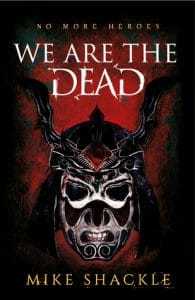 Tinnstra is the daughter of the legion’s and the nation’s finest Shulka warrior, Grim Dagon. Although an extremely extraordinary fighter herself, she is training as an initiate and always holds thoughts of doubt, fear, and incompetence in her mind regarding her potential actions. Putting it simply and abruptly, she is a coward. The Shulka are the elite soldiers. They haven’t lost a war or even a quick skirmish in 700-years. The Egril attackers that the wall and fortress of the Gundan have been erected to keep away decide to try an attack and destroy all who would oppose them in Jia, under the watchful aid and guidance of Emperor Raaku, the son of a God, apparently. In their minds, the only real God.
Tinnstra is the daughter of the legion’s and the nation’s finest Shulka warrior, Grim Dagon. Although an extremely extraordinary fighter herself, she is training as an initiate and always holds thoughts of doubt, fear, and incompetence in her mind regarding her potential actions. Putting it simply and abruptly, she is a coward. The Shulka are the elite soldiers. They haven’t lost a war or even a quick skirmish in 700-years. The Egril attackers that the wall and fortress of the Gundan have been erected to keep away decide to try an attack and destroy all who would oppose them in Jia, under the watchful aid and guidance of Emperor Raaku, the son of a God, apparently. In their minds, the only real God.
The Shulka lose. Quite promptly and emphatically as the Shulka had underestimated their opponents’ martial qualities. They didn’t expect magic, or for armies to appear behind the defensive lines through magical wards, or the grotesque Paradise Lost-esque flying demons – the Daijuka – who wield six feet spears, with another 2 feet of swords on the end for good measure to slaughter all. They are terrifying. The Egril, on porpose, always wore shitty armour and showcased easily destructible defenses as a ploy. Not this time. The Shulka lose as they grossly overexaggerated how weak they thought their opponents were. The ‘Skulls’ as the Egril are known due to their facial attire as can be seen on the cover, win, and occupy the whole of Jia within a few days. It’s not very nice for anybody who was/were there before. Of course, they never wished to welcome random murders, hangings, and totalitarianism. Alas.
Mike Shackle seems like an excellent writer. He’s a truly talented wordsmith and composer of exquisite fantasy fiction. However, at certain points, this wasn’t perfect. There are a few issues that griped me whilst reading but I acknowledge and understand why Shackle did it. It didn’t always work for me, however, I will talk about these before going back to the many many positives. A lot of times the chapters ended up too abruptly to try and heighten or instill drama and intrigue. The words imploded and exploded were featured frequently in the last stage of a chapter. BOOM. End chapter. Often. Explodes. Too many witty, compulsive, oh-wow-where-did-that-come-from twists happened too frequently for me.
I really liked the majority of the Point of View perspectives, by the end. So, we have Tinnstra who I’ve mentioned, Jax – the one prominent remaining Shulka officer who is aiding the resistance against the Skulls, Yas, the loving mother and family orientated individual who has to work behind enemy lines to keep her young child alive, Drem, the young riled-up anarchist. The only real view we get from the opposite/dark side is that from Darus. He’s a Chosen. An exquisitely infamous mage who is a torturer who manipulates and torments similar scenes to those of Glotka in The First Law, but when he knows he isn’t getting the answers he wants, he can grow the limbs or heal the wounds of the afflicted… pain can go on forever. Dark.
Some of the characters didn’t appeal to me straight away. Drem was an angry little cunt. Tinnstra is a coward who has the italic emotion thoughts flaunting through her scenes about how pathetic she is. Yas seems like an idiot too to begin with. I know in some stories you begin with a farmboy or unknowing fool who becomes a hero, somehow. Here, there were a lot of them. With all that being said, their progression was enjoyable to read about after I acknowledged it wasn’t going to occur in a chapter or two.
This narrative is mid to high on the grimdark scale.
“A cruel joke by the four Gods – the tale of the coward, the queen and the mage and how they died.”
Mike’s enthusiasm for being so excited for being able to release a story for Gollancz really shines. He is an enthusiastic, elegant and excellent writer. However, I don’t think this is completely showcased until the last half of the book. My friend, Michael at The Fantasy Hive, had similar views as we read this concurrently. I’m not saying this as a negative, I’m just trying to present that if you think it isn’t for you then give it a bit more time. This is a stunning debut. I’m not sure of the exact history it may be based on but it reminded me of Japan vs. China and the control Japan had when I watched Ip Man. So, I’m not well-sourced or knowledgeable enough to write about legitimate parallels.
We are the Dead is a staggering, marvelous, and gripping fantasy debut that should be acknowledged alongside recent-ish excellent Grimdark debuts such as Ed McDonald, Peter McLean, Anna Smith-Spark, and Dyrk Ashton. We are the Dead isn’t perfect but what it does well, it does really well. Very highly recommended. We are the Dead will feature on many a best-debut of the year list.
Buy We are the Dead by Mike Shackle
The post REVIEW: We are the Dead by Mike Shackle appeared first on Grimdark Magazine.


